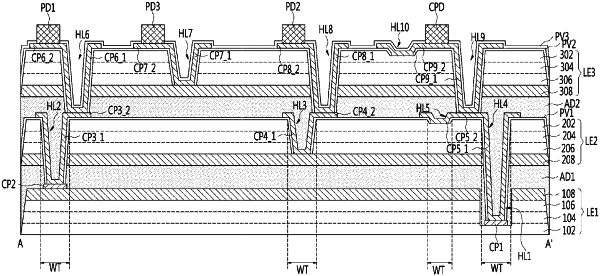| CPC H01L 33/62 (2013.01) [H01L 33/52 (2013.01)] | 20 Claims |

|
1. A light emitting device comprising:
a first light emitting part, a second light emitting part, and a third light emitting part disposed one over another along a first direction, each of the first, second, and third light emitting parts including a first-type semiconductor layer, an active layer, and a second-type semiconductor layer;
a first conductive pattern at least partially disposed between the second and third light emitting parts, the first conductive pattern including a first portion extending in a second direction perpendicular to the first direction and electrically coupled with at least one of the first-type and second-type semiconductor layers of the second light emitting part, and a second portion extending from one end of the first portion and disposed on one surface of the second light emitting part between the second and third light emitting parts;
a second conductive pattern disposed on the third light emitting part and electrically coupled with the third light emitting part; and
a first passivation covering the first light emitting part,
wherein:
the first passivation includes a first portion extending in the second direction, and a second portion extending from one end of the first portion and forming an inclined angle with the second direction, and
the first conductive pattern at least partially overlaps with the second portion of the first passivation.
|